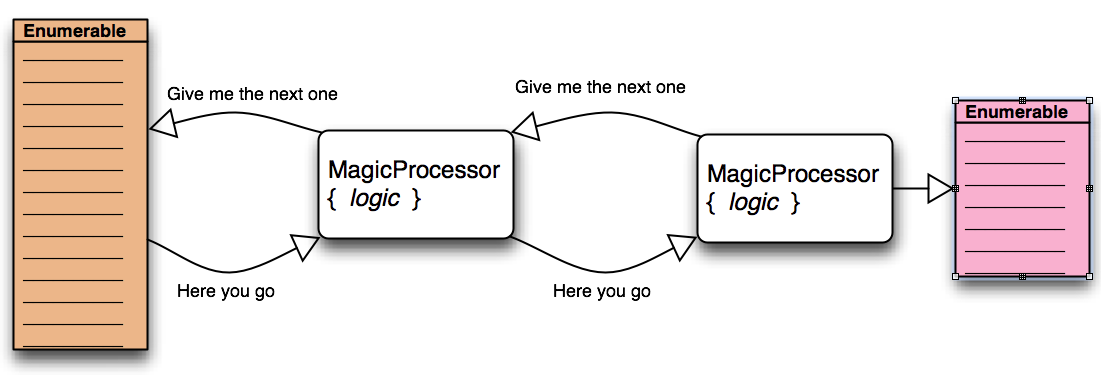A Short Journey
From Higher-Order Functions in Ruby
to Lazy Enumerables
Yuri Leikind
Part 1 – Higher-Order Functions and Ruby

Higher-Order Functions
A higher-order function is a function that does at least one of the following:
- take one or more functions as an input
- output a function
Taking one or more functions as an input
Usual thing for every Javascript developer:
Taking functions as an input in Ruby
Functions which output a function
Higher-Order Functions are essential to the FP paradigm
- Lisps
- Standard ML, OCaml, F#
- Erlang
- Scala
- Haskel
- etc
All of these use higher-order functions as the primary construct.
Higher-order functions in Ruby are also very important.
If fact, functions as arguments are so ubiquitous that there is a special
syntax for it.
Part 2 – Blocks

Blocks
A block is a higher-order function which is an argument to a method call
It is easy to prove that blocks are functions:
The good design of blocks and their terse syntax allow for beautiful code and awesome APIs:
Standard library:
Blocks allow to build your own syntax constructs and DSL’s:
Sinatra
Rails routes:
It all looks like language syntax, but it is not:
Rspec:
More examples
A Rails plugin by yours truly:
Ruby blocks are the reason why Martin Odersky believes that Ruby is a functional language.

More and deeper on Ruby blocks
You can read more on Ruby blocks and how they are special in a post by Yehuda Katz The Building Blocks of Ruby
http://yehudakatz.com/2010/02/07/the-building-blocks-of-ruby/

Part 3 – Higher-order functions on enumerables
Who needs for loops?
when you can build language constructs with blocks and while:
Higher-order methods on enumerables
Using only each Ruby can implement the same set of higher-order methods on enumerables as functional languages:
mapreject(filterNotin other languages)select(filterin other languages)takeflat_mapall?reduce- many more
All these are found in module Enumerable which can be included in any collection class which implements each
Example: map
Example implementation:
Example: select (filter)
Example implementation:
Example: all?
Example implementation:
A more real-life example
One more example
Part 4 – Problem
Problem
Each such method creates a new collection. They can be huge…
We can rewrite this code to process each word one by one. That’s one solution…
But we can solve the problem without changing the API much
This is what we have, a sequential execution:

This is what we need
Our blocks working concurrently, and processing elements one by one:

In other words
|
This is what we have
|
This is what we need
|
The second modus operandi is on demand, it is lazy.
How do we do it?
Part 5 – Fibers

Fibers: lightweight cooperative concurrency
Fibers were added in Ruby 1.9
Here’s what the documentation says:
Fibers are primitives for implementing light weight cooperative concurrency in Ruby. Basically they are a means of creating code blocks that can be paused and resumed, much like threads. The main difference is that they are never preempted and that the scheduling must be done by the programmer and not the VM.
Fibers: Example
Example: Fibonacci numbers as a never-ending fiber
Part 6 – Implementing laziness

Disclaimer
The goal of this implementation is only to demonstrate how laziness can be achieved with the help of fibers.
This is neither a complete nor a true implementation of Enumerable::Lazy in Ruby 2.0.
Beauty and completeness have been sacrificed in favor of simplicity.
Enumerable::Lazy in Ruby 2.0 uses Enumerator added in Ruby 1.9 as the basis.
Enumerator uses fibers. This proof of concept code uses fibers directly because
Enumerator is beyond the scope of this presentation.
Implementation: step 1
Let’s create a wrapper class which will contain a fiber (which in its turn will contain the block defined in the client code)
Let’s add a method in Enumerable which will create an instance of this wrapper out of an enumerable:
Implementation: step 2
The wrapper object should have an API similar to Enumerable. each should be non-lazy, map, select and others should be lazy.
Let’s implement the non-lazy behavior and each. We just access the underlying enumerable via a fiber, no added logic here:
Let’s run it
Oops…
Implementation: step 3
The value of the block is also returned from the fiber, so we have to rewrite each to ignore the last value returned from the fiber.
Implementation: step 4
Let’s implement map and select. We’ll convert the client code block to an explicit function object for the sake of readability.
Implementation: step 5
We are incapsulating the client code block in yet another function which implements the logic of map or select, but it calls
Fiber.yield to return the result, because this function will be called from within a fiber.
Implementation: step 6
Both map and select return a new LazyPanda instance incapsulating new logic. In a way, we are dealing with a Russian doll pattern: the first
LazyPanda incapsulates a real Enumerable, the next LazyPanda incapsulates the first LazyPanda, and so on.
Implementation: step 7
Now we need to modify the constructor. The constructor should have a second optional function parameter. In case such a function is present, the constructor places this function into a fiber instead of the default Fiber.yield(e):
Full source
Let’s test
No output. It is lazy. This code has only created the Russian doll structure. No block has been executed.
Let’s test
Voila!
Achievement unlocked

Further reading if you want to dig deeper
- Fiber documentation (http://www.ruby-doc.org/core-1.9.3/Fiber.html)
- Enumerator documentation (http://www.ruby-doc.org/core-1.9.3/Enumerator.html)
- How do Enumerators work in Ruby 1.9.1?
- Ruby 2.0 Enumerable::Lazy by Innokenty Mihailov (http://railsware.com/blog/2012/03/13/ruby-2-0-enumerablelazy/)
- Pipelines Using Fibers in Ruby 1.9 by Dave Thomas (http://pragdave.blogs.pragprog.com/pragdave/2007/12/pipelines-using.html)
- Articles in Higher-Order Ruby by James Edward Gray II (http://blog.grayproductions.net/categories/higherorder_ruby)
- The Building Blocks of Ruby by Yehuda Katz (http://yehudakatz.com/2010/02/07/the-building-blocks-of-ruby/)